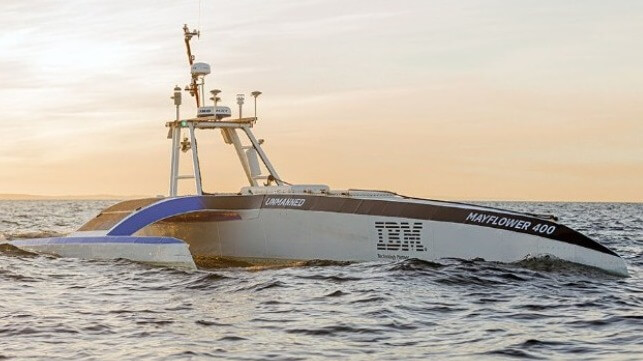Mayflower Autonomous Ship Begins Second Attempt at Atlantic Crossing

The Mayflower Autonomous Ship has departed for its second attempt to cross the North Atlantic from the UK to the U.S. using only its AI systems to navigate the more than 3,000 nautical mile journey. Originally planned to coincide with the 400th anniversary of the Pilgrim’s journey to the new world, the vessel was delayed by the pandemic and then a mechanical failure on its first attempt in June 2021. If it is successful, MAS400 will become the largest autonomous vessel to have ever crossed the Atlantic.
Measuring 50 feet in length and weighing five tons, the craft was developed at a cost of more than $1 million in a research partnership involving the University of Plymouth, IBM, autonomous vessel specialists MSubs, and charity Promare, which promotes marine research. Taking more than four years to develop, the goal of the project is to collect ocean research data during the crossing and demonstrate the emerging capabilities of AI to navigate vessels.
MAS400 is equipped with six AI-powered cameras that provide images to the computers which were educated about land, ships, and other potential obstacles by studying more than one million images. The vessel also has 30 onboard sensors and 15 edge devices. It is feeding data from the voyage back to the team onshore via satellite connections which also permit the public to monitor progress with an online dashboard.
We've set sail and are on our way to the United States!
— AI Captain - Mayflower Autonomous Ship (@AI_Mayflower) April 28, 2022
Led by the AI Captain MAS 400 is now in international waters as it attempts to cross the Atlantic Ocean. Follow our journey through our dashboard: https://t.co/CKfRoDepmV pic.twitter.com/MXJrfl2qcv
The vessel is currently traveling at speeds ranging between 5 and 6 knots reporting that it has traveled over 350 nautical miles since departing Plymouth on April 27. It provides hourly updates to its automated Twitter account. If all goes as planned, it should reach Virginia in approximately three weeks. Unlike its namesake, the project organizers believe the AI computer will be able to prevent it from being blown hundreds of miles off course and arriving in Massachusetts like the Mayflower in 1620.
The team explains that they programmed the system with the planned course and the computers analyze progress determining how to reach the objective, considering weather, currents, and other variables as well as navigating to avoid collisions. The MAS can see approximately 2.5 nautical miles ahead, and it will identify vessels and other hazards in its path. It uses a hybrid system of wind and solar power with a diesel backup generator to power the vessel and its propulsion.
The first attempt to cross the Atlantic began on June 15, 2021, however, the vessel experienced a mechanical failure after completing just over 11 percent of its journey and the team decided to abort the mission and sent a rescue craft to find and retrieve MAS400. They reported that a coupling failed on the generator forcing the vessel to rely solely on solar power. The team determined that it would run out of power if permitted to continue on the voyage.
During the time back at base in England they also used it to improve systems for the craft. In addition to enhancements to mechanical systems to make the craft more robust during the crossing, they also improved the computer vision software.
AI Captain is reporting that all systems are functioning normally as the Mayflower Autonomous Craft entered international waters. Views were posted of a dolphin swimming alongside as it headed out of the English Channel and now the camera show a gray Atlantic with a long horizon ahead.
